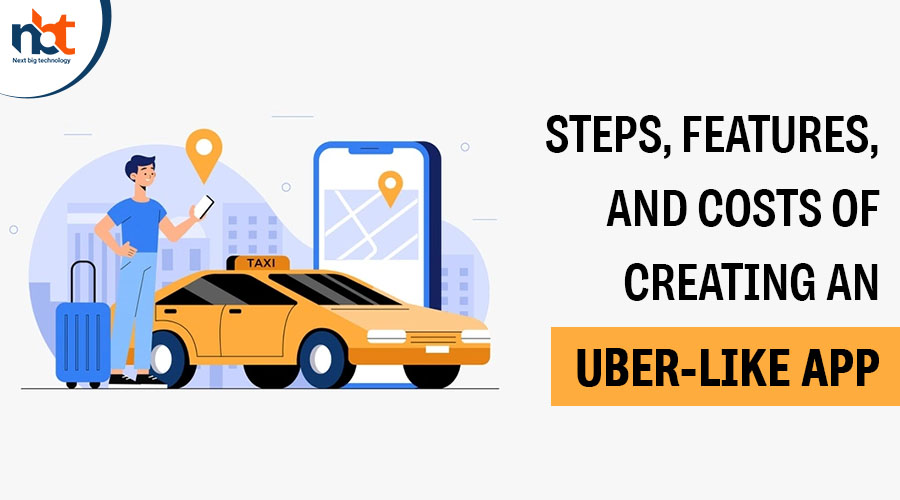Without an Uber-like taxi-hailing app, it’s impossible to envisage a viable ridesharing business. And this is why:
Taxi apps have nearly supplanted traditional ride-hailing services, and they’re here to stay.
For taxi business owners and entrepreneurs that wish to offer cab booking services, smartphone applications are now a requirement.
Unfortunately, having an app isn’t enough to win the competition.
You’ll encounter stiff competition if you enter the taxi industry. You’ll have to compete with cab booking apps like Uber and Lyft, which have millions of users and billions of dollars in sales.
But there is a way out. You must provide people a reason to prefer your cab booking app over competitors in order to be successful. In other words, a strong and well-known brand with a compelling value proposition is required for your taxi booking business.
A dependable tech partner – an app development business that knows everything there is to know about taxi app development and related technologies – is another essential to success for a taxi app solution.
Let’s speak about ways to compete with Uber, taxi app business methods, and key features to include in your project. We’ll also provide an estimate for Uber app development costs and discuss the stumbling blocks we encountered when developing the ride-sharing app.
But first, let’s take a look at the whole development process for taxi booking apps.
Also Read : What Are the Cost & Features Required to Develop A Tow Truck App Like Uber
Table of Contents
A step-by-step tutorial on how to create a taxi booking app.
Step 1: Create a one-of-a-kind value proposition.
Your taxi app should provide distinct benefits to both drivers and riders.
Step 2: Determine your niche
You’ll need to discover a low-competition niche in the taxi booking app industry.
Step 3: Decide on a revenue scheme
You must choose between charging commissions and doing paid promotions.
Step 4: Construct your vision
You must gather project specifications and provide them to the taxi mobile app development team.
Step 5: Create technical documentation for a taxi booking app
The team develops a technical definition for your product, generates user stories, recommends architecture, and implements the tech stack.
Step 6: Create the MVP
Create the MVP of your Uber-like app Taxi app developers prioritise user stories and conduct unit testing to detect and repair bugs.
How to Create a Successful Taxi Booking App
As previously said, the ridesharing industry is crowded. The major firms in this industry are the cab booking applications Uber and Lyft. Uber has 70% of the market share in June 2020, whereas Lyft barely had 30%.
But, believe us when we say that your new taxi app can succeed even in a competitive industry.
Let’s have a look at how.
Make a one-of-a-kind value proposition
For your taxi booking app to stand out from the competition, you’ll need a unique value proposition. It is also possible to leverage a value proposition to entice drivers and passengers to use an app similar to Uber’s Taking a look at what your competitors are offering will help you determine your value proposition.
Uber
In the cab app business, Uber is the most major participant. This cab booking app has 55 million monthly active users and is available in 67 countries and 78 cities.
Uber’s value propositions are as follows:
Easy and Quick Riding at a Reasonable Price
While the first value proposition highlights the app’s convenience, the second statement claims that Uber has a reasonable price strategy that makes taxi services open to anybody, which is correct. Uber was the first taxi service to charge fares based on the distance travelled rather than a fixed cost.
Lyft
The second-largest cab booking app is Lyft. Unlike Uber, Lyft is exclusively available in the United States (65 cities in 30 states). Lyft’s brand offers two different benefits:
In minutes, you’ll be able to ride.
Take a seat behind the wheel.
The first value proposition is for customers seeking a cab in a hurry, while the second is for drivers interested in joining Lyft’s fleet and earning money by carrying passengers.
Have you observed how both taxi applications employ a feeling of urgency while ignoring the passenger’s status, car choices, or membership in a certain community?
HYPR, a London-based start-up, is a taxi booking app that established its value proposition on prestige and luxury. The value proposition for HYPR is as follows:
Ride-Hailing Club for the Rich and Famous
HYPR offers consumers a sensation of belonging to an exclusive group of affluent and successful individuals in this way. HYPR also lives up to users’ expectations.
The firm operates on a subscription basis and has a fleet of premium automobiles, including Lamborghini and Gelentwagen.
To get access to the HYPR passenger app, fill out the application form and join the waitlist. Another method is to ask an existing HYPR client for an invitation code.
In a word, don’t try to replicate other taxi service applications to create your brand. Instead, think of anything that will set your taxi app apart, put it into words, and voila! You’ve just established a one-of-a-kind value offer.
Find your area of expertise
At first appearance, the taxi sector appears to have only one specialty. This is not the case.
For example, there’s a market for electric taxis that may be useful for your taxi booking software. Why?
People are more concerned about environmental concerns now than they have ever been. As a result, people make intentional decisions in favor of ecologically sustainable modes of transportation.
Green Cabs Taxis, a popular ecologically friendly auto booking app in New Zealand, is one example. Because they employ electric cars and include tree-planting donations with each fare, the firm touts themselves as guilt-free.
Alternative vehicles, such as motorcycles, are another popular specialty. It has little competition since providing an on-demand bike taxi is unique, at the very least.
Take a look at some of the most popular taxi apps that also provide bike-hailing services:
GrabBike, an on-demand bike service company with 5,997,330 reviews on Google Play, operates across Thailand. GrabBike customers may mail parcels and papers to bike drivers in addition to purchasing motorcycles.
Rapido is a bike taxi service that operates in 40 Indian cities. The app has over 2 million users and has provided over 10 million rides.
LimeBike, a motorbike-riding business located in London, guarantees consumers the quickest route to and from the airport as well as the safest mode of transportation in the city.
In addition to Brazil, China, Pakistan, and the United States, on-demand bike taxis are accessible in Brazil, China, Pakistan, and the United States. However, just a few people have an app that allows them to summon a bike. As a result, if you are from one of the nations listed above, you have an opportunity to build the first bike taxi app and make it a success.
Expand your business to different nations
If you’re thinking of creating a cab service app, don’t limit yourself to your own country’s boundaries. Why?
Fortunately, there are certain nations where Uber is not available or is only partially available. Denmark, Hungary, Thailand, and Canada are only a few examples.
This indicates that these nations offer ideal market conditions for your taxi-hailing services.
How can taxi-hailing applications be made profitable?
The following strategies may be used to transform a taxi booking application into a profitable business:
Passengers pay a commission. A service commission fee of 20-25 percent of the total transportation cost might be charged to passengers.
Fees for services rendered. Passengers might be charged a set booking cost as well as extra service fees for security, customer service, and payment processing.
Fees for cancellations. This form of payment might be used as a punishment if a passenger cancels a ride.
Promotions from third parties. Uber, for example, generates money by collaborating with well-known businesses on advertising campaigns (Hilton, Pepsi, and Spotify). While Uber earns advertising fees, companies connect with app users, and consumers benefit from branded marketing campaigns in the form of incentives, gifts, and treats.
Advertising. You can charge a cost-per-click or cost-per-impression fee for running adverts in your taxi booking app.
You should contact the development team and ask them to design a taxi app if you have a unique value proposition and business plan.
How do you make an Uber-style cab app?
To create a cab app like Uber, a taxi app developer must go through the following stages:
Make a vision for the project
Mobile apps are developed to address a specific need that customers have. So in order to create an effective taxi app, you need to think about who your target audience is, what problems they have, and how technology might help solve those problems. This form of knowledge is referred to as a project vision.
You must attend a Workshop, a brief (2-8 hours) brainstorming session with our development team if you do not have a clear project concept for a taxi app like Uber.
During the Workshop, we’ll assist you in shaping and validating your company concept. We’ll also develop a bullet-proof project vision for a taxi booking app, recommend viable technologies, and present a more tailored commercial offer.
Create technical documentation for a taxi app
Every project requires technical documentation. It tells taxi app developers what they need to know about the system they intend to build. We generate it in-house during the Inception or Discovery phases because our customers do not have a documented technical document.
The Discovery phase assists developers in defining what your project should and should not accomplish, as well as writing use cases and user stories and defining functional and business requirements. You’ll get the project’s technical documentation, a clickable app prototype, and technologies to use at the end of the Discovery phase.
Create the minimum viable product (MVP) for a mobile taxi app
Minimum viable product is the acronym for. Just a few basic functions are included to allow customers to download and rate the app.
During the Inception phase, when technical documentation is complete, we prioritize functionality for the app’s MVP.
Startups may use MVP to launch taxi booking apps without investing more resources and then add additional features later.
Features of the passenger app
Sign up and log in (Android from 56 hours, iOS from 56 hours)
Passengers may log onto the app using their phone number and a verification code sent through SMS. Personal information about the user, such as name, registration date, and contact information, is also included in this part.
Profile of a passenger (Android from 32 hours, iOS from 32 hours)
Allows passengers to make changes to their personal information, credentials, and password.
Methods of Payment (Android from 32 hours, iOS from 32 hours)
Includes a list of payment options (cash or credit card) so that the traveler may select his or her chosen way of payment.
Set the user’s location (Android from 16 hours, iOS from 16 hours)
Thanks to Google Map API connection, the app may specify the passenger’s location.
Make a cab request (Android from 52 hours, iOS from 52 hours)
Allows the passenger to request a cab and choose their destination. Passengers may also see the cost of the journey and the projected time of arrival. Passengers can also alter the itinerary by adding multiple destinations.
Complementing (Android from 16 hours, iOS from 16 hours)
Allows the app to link passengers with nearby drivers.
Look through the list of available drivers (Android from 40 hours, iOS from 40 hours)
Displays a list of drivers together with extensive information about their vehicles and customer feedback.
A trip is on the way (Android from 62 hours, iOS from 62 hours)
A countdown for when the driver will arrive is included, as well as the ability to change ride parameters, track the driver’s location, and cancel the ride.
Payment is made over the internet (Android from 62 hours, iOS from 62 hours)
Passengers can pay with their credit card using a third-party payment gateway that is incorporated into the system.
Publication of information (Android from 48 hours, iOS from 48 hours)
The passenger receives push alerts informing them that the driver has authorized the request, that the driver is nearby, that the app has debited the credit card, and that the driver has canceled the request.
Features of the Driver App
Sign up and log in (Android from 56 hours, iOS from 56 hours)
Allows drivers to use the app by entering their phone number and obtaining a verification code through SMS. The driver should also supply information on his or her vehicle’s registration and verify his or her bank account information.
Profile of the driver (Android from 48 hours, iOS from 48 hours)
Drivers’ personal information (name, phone number, car details, etc.) is saved and may be edited by the driver.
Geographical place (Android from 8 hours, iOS from 8 hours)
With built-in street navigation, it assists the driver in getting to the passenger destination (Google Map API).
Attractions (Android from 42 hours, iOS from 42 hours)
Displays search parameters as well as a list of comprehensive information about the requests.
Confirmation of trip request (Android from 32 hours, iOS from 32 hours)
Allows you to confirm your trip, wait for passenger confirmation, and then cancel your request.
Journey (Android from 36 hours, iOS from 36 hours)
The information includes the passenger’s permission of the ride, notification that the driver has arrived, and the start and finishes times of the journey.
Also Read : Uber Health Clone Application features and cost
How much does it cost to create an Uber-style app?
The cost of developing a taxi app is determined by a number of things. They are the core technical knowledge of the development team, the team’s location, and the number of features.
Core technical competence denotes that the development team has completed similar projects in the past and is familiar with the technologies required to complete them. It also implies that taxi app developers will spend less time conducting preliminary research, resulting in a lesser cost and faster delivery of a mobile taxi app.
The hourly rate of a taxi app developer is determined by the location of the taxi app development team. Developers in the United States and Canada charge between $100 and $250 for ride-hailing app development services, whereas developers in Eastern Europe charge between $35 and $50 per hour of coding.
When it comes to the app’s functionality, the formula is simple: the more features you wish to include, the greater the app’s development cost.
If you require a more accurate estimate in hours for the MVPs, here’s what you’ll need from The APP Solutions’ taxi app developers:
For the passenger app, it starts at 416 hours.
For the driver’s app, it starts at 222 hours.
A dispatcher panel might take up to 182 hours to complete.
Remember to include PM, QA, and bug-fixing services, which will account for 20-30% of the final project cost.
However, before you hire taxi app developers, think about the issues that might occur throughout the development process.
The most common blunders in taxi app development
We supplied taxi booking app development services to HYPR, a luxury ride-hailing app based in London, here at The APP Solutions.
We ran into the following challenges when developing the app:
London Transportation Regulations
Lost and recovered items, complaints and compliments, car data, booking records, and private hire drivers are all subject to TfL’s rigorous regulation.
As a result, we customized our taxi app solution’s technical documentation to the Transport for London Technical Solution Demonstration Guidance and Technical Documentation Guidance for PHO Applicants in order to make it TFL-compliant.
Algorithm for price aggregation
We wanted to create a bespoke pricing algorithm that takes into account the driver’s position, the length of time he or she waits for the passenger, the distance, and other factors.
Phone numbers that are hidden
The app’s users are successful and well-known individuals who value their privacy. As a result, we had to substitute genuine phone numbers with random London phone numbers.
Check out the HYPR case study to discover more about our application development difficulties and solutions.
Creating the most effective taxi solution that dominates the market
The taxi booking app sector is more competitive than hospitable to newcomers. Nothing is impossible if you have a distinctive value proposition, a solid project vision, and a dependable app development business.
You may utilize our feature list to construct a taxi app for your area or ask our business analyst to choose features that are specific to your value proposition and company goals.
Also, keep an eye out for potential dangers in mobile app development.
Despite being a privately owned company, your taxi app solution must adhere to local government rules. Consider seeking advice from your local transportation organization, as well as guidelines for user data, privacy policies, and security, if you’re planning to launch an app that provides public taxi services.
If you need assistance with taxi app development, we can assist you. Let us know about your company concept, and we’ll do all we can to make it a reality.
However, before you hire taxi app developers, think about the issues that might occur throughout the development process.
The most common blunders in taxi app development
We supplied taxi booking app development services to HYPR, a luxury ride-hailing app based in London, here at The APP Solutions.
We ran into the following challenges when developing the app:
London Transportation Regulations
Lost and recovered items, complaints and compliments, car data, booking records, and private hire drivers are all subject to TfL’s rigorous regulation.
As a result, we customized our taxi app solution’s technical documentation to the Transport for London Technical Solution Demonstration Guidance and Technical Documentation Guidance for PHO Applicants in order to make it TFL-compliant.
Algorithm for price aggregation
We wanted to create a bespoke pricing algorithm that takes into account the driver’s position, the length of time he or she waits for the passenger, the distance, and other factors.
Phone numbers that are hidden
The app’s users are successful and well-known individuals who value their privacy. As a result, we had to substitute genuine phone numbers with random London phone numbers.
Check out the HYPR case study to discover more about our application development difficulties and solutions.
Creating the most effective taxi solution that dominates the market
The taxi booking app sector is more competitive than hospitable to newcomers. Nothing is impossible if you have a distinctive value proposition, a solid project vision, and a dependable app development business.
You may utilize our feature list to construct a taxi app for your area or ask our business analyst to choose features that are specific to your value proposition and company goals.
Also, keep an eye out for potential dangers in mobile app development.
Despite being a privately owned company, your taxi app solution must adhere to local government rules. Consider seeking advice from your local transportation organization, as well as guidelines for user data, privacy policies, and security, if you’re planning to launch an app that provides public taxi services.
If you need assistance with taxi app development, we can assist you. Let us know about your company concept, and we’ll do all we can to make it a reality.
Thanks for reading our post “STEPS, FEATURES, AND COSTS OF CREATING AN UBER-LIKE APP”, please connect with us for any further inquiry. We are Next Big Technology, a leading web & Mobile Application Development Company. We build high-quality applications to full fill all your business needs.










